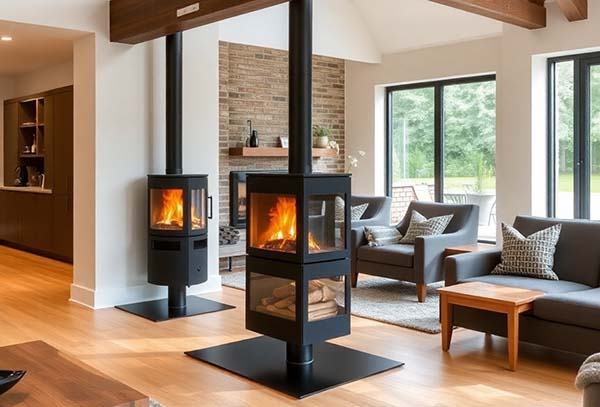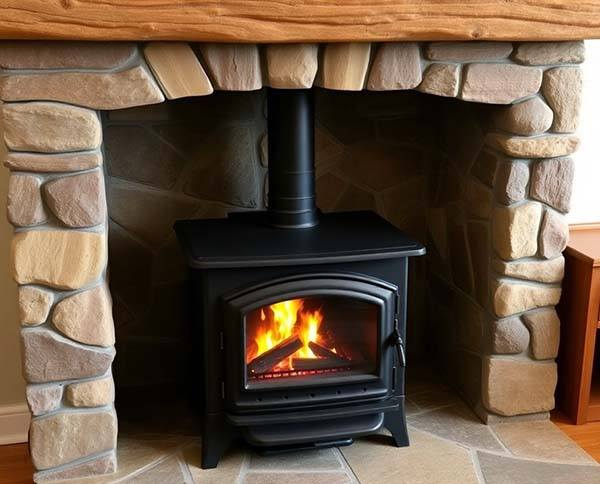Expert tips for a clear view
By Wes Dodd – WD Wood Burner Installations, Poole, Bournemouth & Dorset
One of the joys of a wood burner is sitting back and watching the flames dance through the glass. But if you’ve owned a stove for a while, you’ll know the frustration of blackened or cloudy glass. It doesn’t just spoil the view – it can also be a sign that your stove isn’t running as efficiently as it should.
As a HETAS-approved wood burner installer in Poole, Bournemouth, and Dorset, I’m often asked the same question: “How do I keep my stove glass clean?” Here’s my guide to understanding why the glass blackens – and how to keep it sparkling.
Why Does Stove Glass Go Black?
- Burning wet logs: High moisture content creates smoke and tar, which stick to the glass.
- Poor airflow: If the air vents are closed too soon, combustion is incomplete, leaving residue.
- Slumbering fires: Leaving the stove smouldering overnight reduces efficiency and creates soot.
- Dirty chimney or flue: Poor draw means smoke isn’t pulled away properly.
How to Prevent Black Glass
1. Use the Right Wood
- Always burn seasoned or kiln-dried logs under 20% moisture.
- Hardwoods like oak and ash burn cleaner and hotter.
- Avoid damp wood or rubbish – they’ll quickly blacken the glass.
2. Maintain Good Airflow
- Keep the airwash vent open when lighting and during the first 20 minutes.
- Don’t close vents completely – the fire needs oxygen to burn cleanly.
3. Burn Hotter Fires
- Small, hot fires are cleaner than low, smouldering ones.
- Avoid slumbering your stove overnight – it increases soot and creosote.
4. Sweep Regularly
A blocked chimney or flue can restrict draw, making the stove smoky and dirty.
How to Clean Stove Glass
Even with good practices, your glass will still need a clean now and then. Here’s how:
- Cool the stove completely before cleaning.
- Use a damp cloth dipped in ash to gently scrub soot away. It’s natural and effective.
- Alternatively, use a specialist stove glass cleaner for tough stains.
- Avoid abrasive pads or harsh chemicals – they can scratch or damage the glass.
Comparison Table – Good vs Bad Practices
| Action | Result on Glass |
|---|---|
| Burning kiln-dried logs | Cleaner, clearer glass |
| Burning wet logs | Blackened, smoky residue |
| Keeping airwash vent open | Glass stays clean |
| Closing vents too early | Heavy soot build-up |
| Cleaning with ash or stove cleaner | Safe, streak-free cleaning |
| Cleaning with abrasives | Scratches and cloudy glass |
FAQ: Stove Glass Cleaning
1. Can I use normal glass cleaner on my stove?
No – most glass cleaners aren’t designed for high-heat surfaces. Always use stove-specific cleaners or the ash method.
2. Why does the black build up more on one side of my glass?
This is usually due to uneven airflow. Check your airwash system and make sure your stove door seals are intact.
3. How often should I clean the glass?
It depends on usage, but for regular burners, once a week is common. With dry wood and good airflow, you may only need to clean occasionally.
4. What’s the quickest way to clean it?
The ash method – a damp cloth dipped in fine ash from your stove, wiped in circles, then buffed with a clean cloth.
5. Is blackened glass dangerous?
No – but it’s a sign your stove isn’t burning efficiently, so it’s worth fixing the root cause.
Final Thoughts
Keeping your wood burner glass clean is about more than just appearances. It’s a sign that your stove is burning efficiently, your wood is good quality, and your chimney is working properly.
Download our FREE wood burner glass cleaning guide here.
As your local expert in Poole, Bournemouth, Christchurch, Wimborne, Swanage, Wareham, and Corfe Mullen, I can help with installation, servicing, and chimney sweeping to keep your stove performing – and your glass sparkling.
👉 Contact WD Wood Burner Installations today for professional fitting, sweeping, and expert advice across Dorset.




